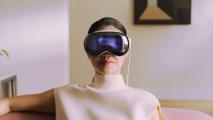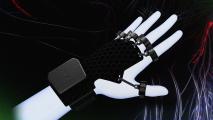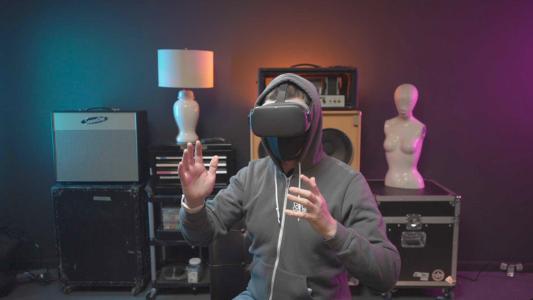This article is an installment of The Future Explored, a weekly guide to world-changing technology. You can get stories like this one straight to your inbox every Thursday morning by subscribing here.
Soon, you may be able to experience walking in virtual reality…without needing to take a single step. Researchers in Tokyo have created a VR platform that simulates the sensation of walking — even if you’re sitting down.
The Challenge: VR lets us have all kinds of experiences we might never have IRL, but there’s one basic experience the industry hasn’t figured out how to replicate: walking. It doesn’t matter how rich the virtual environment appears, your experience is still confined to the physical space you’re in…and more than a few players have forgotten this vital fact in recent years.
Walking activates perceptions in our bodies that are different from standing or sitting, although we’re not conscious of them. For example, our inner ears and eyes adjust to the motion of walking.
Unfortunately, most of us don’t have the living room space to be able to walk in VR — and this creates dissonance for our bodies, making the experience less realistic. That’s why you often see games in VR using teleportation — it allows you to zip wherever you want in an environment, which is super helpful for moving your avatar 20ft in the virtual world when you only have 6ft of space in your living room.
VR researchers have already started cracking the code on how to facilitate the experience of walking through the “unlimited corridor” approach — using the sensation of touch on a curved wall to “trick” the brain into thinking a circular path is straight. Of course, this still requires the space to install a big circular wall, which most people aren’t likely to have.
Why walking matters: Aside from making virtual worlds more realistic, the ability to simulate the sensation of walking would allow people with mobility issues to experience what it feels like to walk. It fits in with a bigger push to find ways to use the unique properties of VR immersion for health and wellbeing, from physical therapy to stress reduction to easing phantom limb pain.
Now, a new platform is underway that could make walking in VR as easy as…sitting down.
A big step: In a recent paper, researchers from Toyohashi University of Technology and University of Tokyo propose a new custom-built platform for simulating the experience of walking that works when users are sitting still.
The study explored whether a full-body avatar or hands-and-feet-only avatar — viewed in either first or third person perspective — can best simulate the feel of walking on the custom-built platform.
Participants were divided into groups that experienced the full-body avatar (in both the first person perspective, where they “were” the avatar, and third person perspective where they just saw the avatar on screen) and as “hands-and-feet-only” avatars, also in both perspectives. All participants had vibrators — made of wood plates and aluminum springs — connected to their feet. The vibrators allowed the person to sense motion whenever the avatar moved in the virtual world.
Then, while remaining seated on a stool in the physical world, the participants “moved” down a virtual corridor replete with a textured floor and wooden walls.
The findings: First person FTW.
The study showed that a walking avatar in first person — whether full bodied or just hands-and-feet — greatly enhanced the sensation of walking. No one who experienced an avatar in the third person felt the walking sensation.
More research will be required to rigorously explain this phenomenon, but it’s not hard to see why this was the case. When you are the character, and external sensations match what “your” body would be feeling in the virtual environment, it reads as something happening to you. When you feel like you’re operating a character, on the other hand, the simulation probably hits the same register as the buzzes you feel in your smartphone or video game controller.
Next steps: The researchers believe this system could be miniaturized and sold for $300-500 — and based on photos, miniaturization would definitely be needed to comfortably fit in most people’s homes. It may be an unnecessary add-on for some users, but like 3dRudder, it might be a haptic device that those with accessibility needs (and plain-old power users) turn to to give their VR that extra kick of immersion.
We’d love to hear from you! If you have a comment about this article or if you have a tip for a future Freethink story, please email us at [email protected].






